A good designer becomes great with the right tools in a fast-paced UI/UX design world. Having the best UI design tools is crucial to efficiency and innovation.
This article shares with designers the top-rated tools for 2025 that can greatly enhance their workflow, making the design process more efficient and creative.
Design tools are constantly changing to meet the dynamic needs of designers. Therefore, new solutions keep emerging at any given time. To remain competitive and expand limits in UI and UX design, it is important to stay updated on what’s new with these resources.
Top 10 User Experience Tools for 2025 - April 2025 Reviewed
Figma
Source: figma
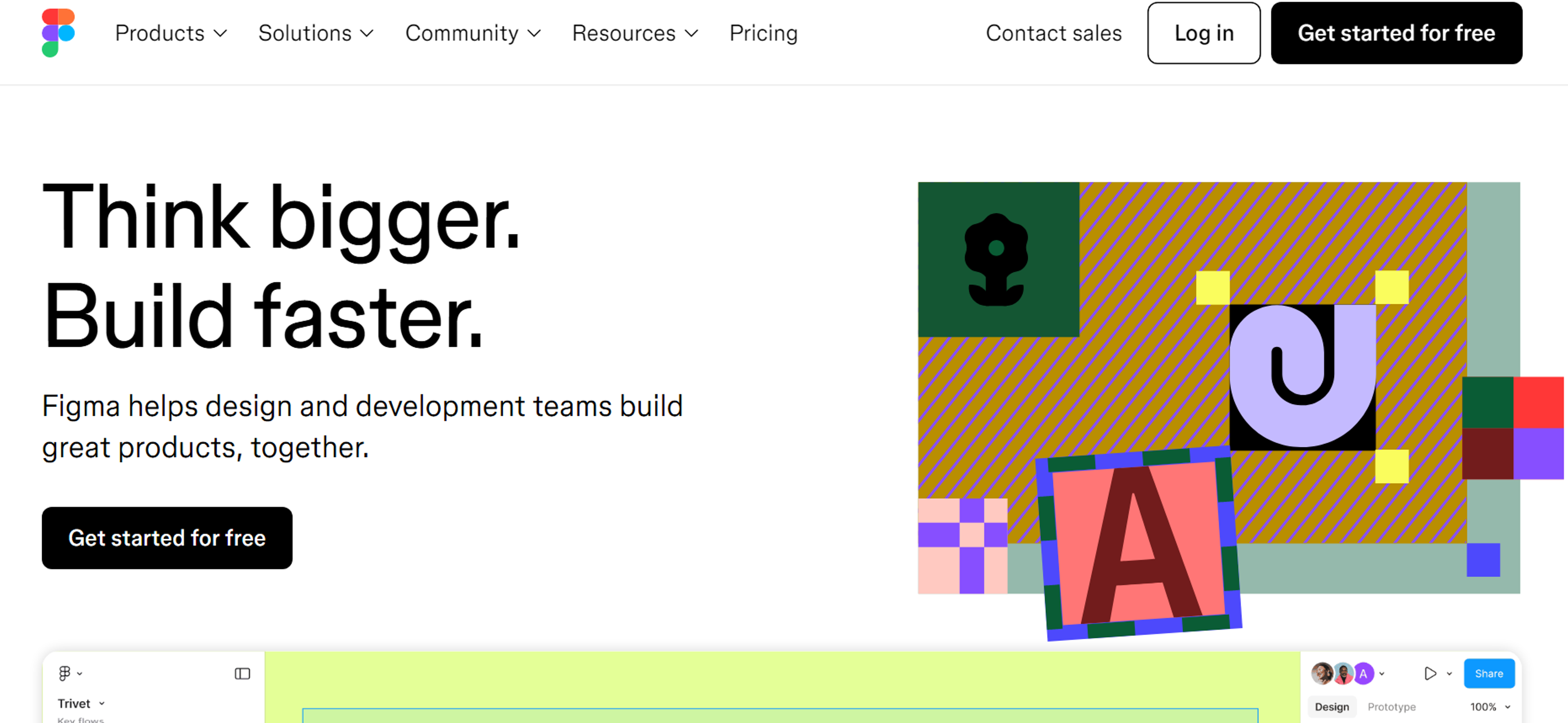
- Category: Interface design
- Why it’s the best: Its smooth collaborative workflow and all-in-one feature set empower fast iteration and team synergy, which is crucial for modern, agile design processes.
- Price: free, professional - from €5/mo to €20/mo
- Available on: Web (browser-based), Windows, macOS
- Overall Rating: 4.8/5
Figma is a cloud-based design and prototyping platform known for its real-time collaboration and all-in-one workflow. It supports vector UI design, interactive prototyping, and design systems in a single platform. You can design interfaces collaboratively in the browser and instantly preview or share prototypes.
Its robust features (auto-layout for responsive design, component libraries, plugins, etc.) make it ideal for everything from wireframing to high-fidelity design. Notably, Figma’s multiplayer editing lets multiple designers work simultaneously, and its FigJam whiteboard tool aids in brainstorming and user flows.
- Pros: Multiple users can edit simultaneously, akin to Google Docs for design.
- Cons: Limited offline functionality; desktop app requires periodic sync.
UserTesting
Source: UserTesting

- Category: User Testing & Feedback
- Why it's the best: Widely recognized for its ease of use, massive user pool, and real-time feedback, making it the go-to platform for usability testing
- Price: $16,900 to $136,800
- Available on: desktop/mobile
- Overall Rating: 4.3/5
UserTesting is a leading platform that provides companies with on-demand access to real users for testing digital products and experiences. Founded in 2007, the company has grown to become a major player in the user experience (UX) research industry, serving thousands of clients across various sectors.
The platform allows businesses to quickly recruit participants from a diverse pool of over 1 million users worldwide. These participants can then engage in various types of tests, including usability studies, prototype evaluations, and concept testing.
Companies can observe users interacting with their websites, apps, or prototypes in real time, gaining valuable insights into user behavior, preferences, and pain points. This approach enables organizations to make data-driven decisions about their digital products, ultimately leading to improved user experiences and increased customer satisfaction.
UserTesting's services have become increasingly important in today's digital-first world, where user experience can significantly impact a company's success.
By providing rapid feedback and actionable insights, UserTesting helps businesses iterate faster, reduce development costs, and mitigate the risks associated with launching new products or features. The company's client base includes many Fortune 500 companies, as well as smaller startups and mid-sized businesses across various industries.
- Pros: Easy to set up, diverse user pool, provides real-time video feedback
- Cons: Expensive for small teams, limited customization options in surveys
Miro
Source: sorryonmute.com
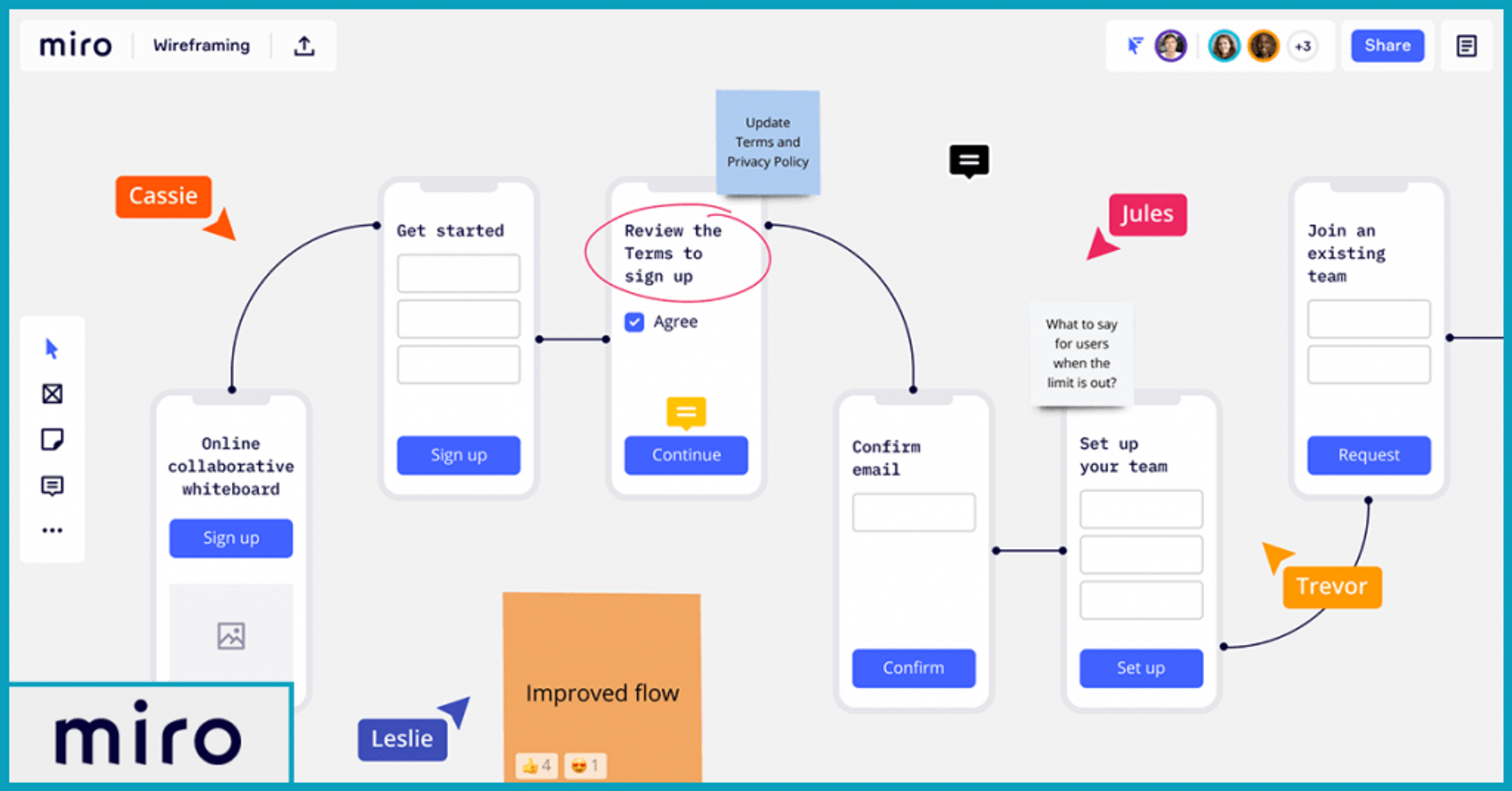
- Category: Collaborative Online Whiteboard / Visual Collaboration Tool
- Why it’s the best: Miro stands out as the best collaborative whiteboard platform thanks to its intuitive interface, robust feature set, and seamless integrations. It’s perfect for brainstorming, planning, diagramming, and real-time team collaboration, whether you’re remote or hybrid.
- Price: Free; Starter: $10/user/month; Business: $20/user/month; Enterprise: Custom pricing
- Available on: Web, macOS, Windows, iOS, Android
- Overall Rating: 4.8/5
Miro is a collaborative online whiteboard platform that enables teams to brainstorm, plan, and execute projects visually - no matter where they are. Designed for remote and hybrid teams, Miro offers an intuitive interface packed with tools like sticky notes, drawing pens, mind maps, and flowcharts.
Whether you’re running a design sprint, mapping out user journeys, or conducting a team retrospective, Miro brings structure and clarity to even the most complex ideas.
One of the standout features of this user experience platform is its extensive library of templates that cater to a wide range of use cases. From product roadmaps to customer journey maps, teams can hit the ground running without starting from scratch.
Miro also integrates with tools like Slack, Microsoft Teams, Zoom, Jira, Asana, and Notion - making it easy to embed Miro into your existing workflows. Miro can also be used to create and visualize user flow diagrams, helping designers structure product experience and information architecture effectively.
For creative and agile teams, Miro is more than just a digital whiteboard - it’s a central hub for idea development and visual storytelling. Designers can wireframe, product managers can track OKRs, and marketers can map out content strategies, all in one unified space. With powerful permissions and sharing options, Miro also makes it easy to collaborate across departments or invite external stakeholders into the conversation.
Like any tool, Miro isn’t without its challenges. Some users may find the learning curve steep, especially when first introduced to its vast feature set. Additionally, while the free version is great for small projects, larger teams will likely need to upgrade to paid plans to unlock features like unlimited boards, advanced security, and admin controls.
- Pros: Intuitive, flexible visual interface
- Cons: Can feel overwhelming for first-time users
ProtoPie
Source: Protopie
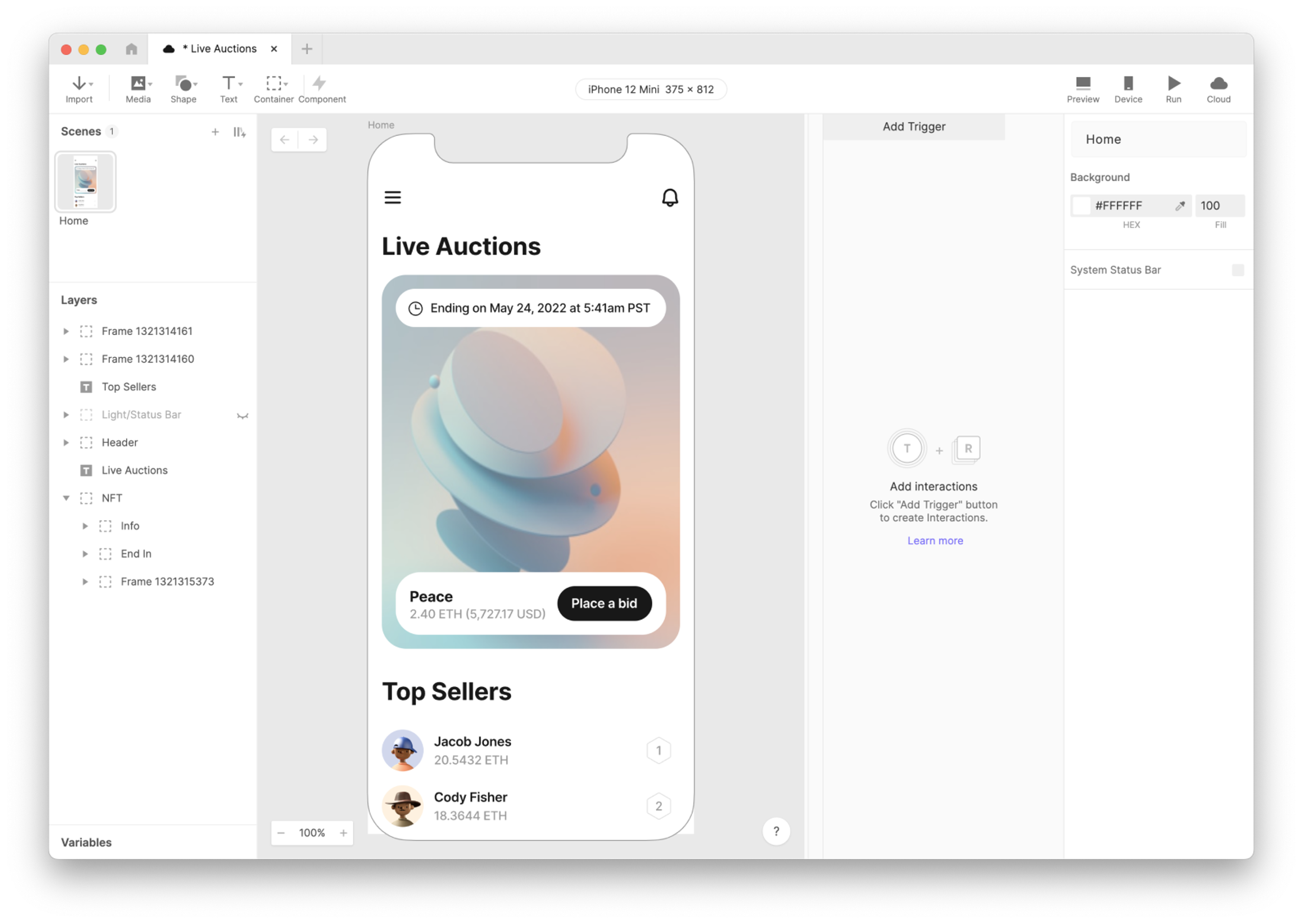
- Category: Interactive Prototyping
- Why it’s the best: Excellent for creating complex interactive prototypes without coding, favored by designers for its flexibility and ease of use
- Price: Free, Basic $25/mo, Pro $47/mo
- Available on: desktop
- Overall Rating: 4.5/5
ProtoPie is a powerful and intuitive prototyping tool designed to create interactive prototypes and highly realistic digital product designs. It allows designers and developers to create functional prototypes for mobile apps, websites, and other digital interfaces without the need for coding skills.
ProtoPie’s strength lies in its ability to handle complex interactions and animations, making it possible to simulate advanced features and user flows that closely mimic the final product.
This user experience platform boasts advanced prototyping capabilities, enabling the creation of interactive and dynamic prototypes essential for usability testing and refining ideas before development.
ProtoPie can also generate design specs along with interactive prototypes, streamlining the design process and facilitating collaboration.
One of ProtoPie’s key features is its ease of use combined with powerful functionality. It employs a visual, drag-and-drop interface that allows users to quickly build prototypes while also offering advanced capabilities for those who want to create more sophisticated interactions.
The tool supports various input methods, including touch, voice, and device sensors, enabling designers to create prototypes that respond to various user inputs and environmental factors.
ProtoPie also facilitates collaboration and handoff between design and development teams. It allows for easy sharing of prototypes within the team and with clients through cloud-based services.
This tool can generate specifications and interaction details that developers can use to implement the design accurately. This bridges the gap between design and development, streamlining the product creation process and reducing miscommunication between team members.
- Pros: Powerful for interactions and animations, no coding required
- Cons: Expensive for individual users, requires time to master
Hotjar
Source: Hotjar

- Category: Analytics & Feedback
- Why it's the best: Offers a comprehensive suite of tools for heatmaps, session recordings, and feedback collection, making it one of the most popular tools for understanding user behavior
- Price: Free, Growth $40/mo,
- Available on: desktop, mobile, tablet
- Overall Rating: 4.2/5
Hotjar is a popular web analytics and user feedback tool designed to help businesses understand and improve their website’s user experience. Founded in 2014, Hotjar provides a suite of features that allow website owners and marketers to gain insights into visitor behavior and gather feedback directly from users.
The platform’s key features include heatmaps, which visually represent where users click, move, and scroll on a webpage; session recordings, which capture how users interact with your website, providing detailed insights into their behavior and engagement; and conversion funnels, which help identify where users drop off in the conversion process. Hotjar can also be integrated into project management workflows to enhance collaboration and organization among design teams.
This user experience platform also offers survey and feedback tools, enabling businesses to collect qualitative data from their visitors. These features combine to provide a comprehensive view of user behavior and preferences, allowing companies to make data-driven decisions to optimize their websites and improve conversion rates.
Hotjar offers various integration capabilities:
1.
CMS platforms (WordPress, Shopify, Wix)2.
Analytics tools (e.g., Google Analytics)3.
CRM systems4.
A/B testing tools5.
Tag management systems (e.g., Google Tag Manager)6.
API access for custom integrations
These integrations allow for seamless data sharing, easier setup, and more comprehensive insights when combined with other business tools.
- Pros: Comprehensive heatmaps and session recordings, easy to set up
- Cons: Expensive for large traffic websites, lacks advanced A/B testing
OpinionX
Source: opinionx.co
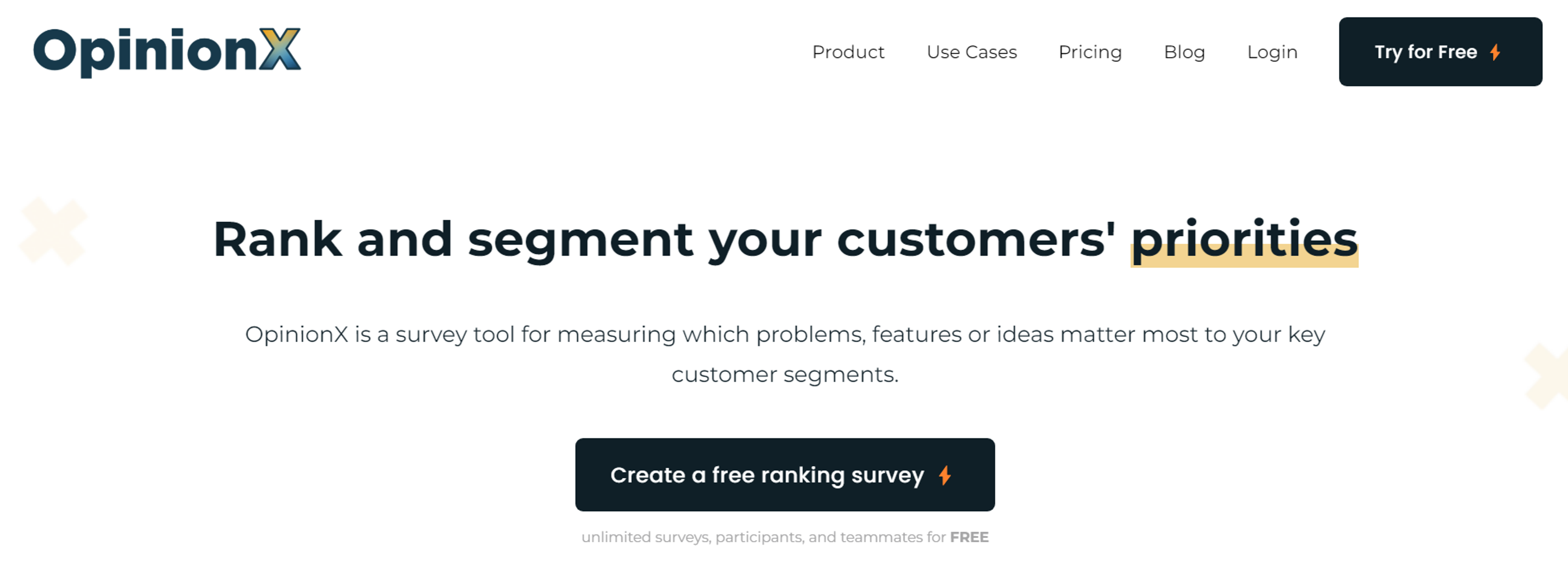
- Category: Survey & Prioritization Tool / User Research
- Why it’s the best: OpinionX is the best tool for gathering and prioritizing qualitative user feedback through collaborative surveys. It’s designed to help teams identify what matters most to their users by combining open-ended questions with a voting system.
- Price: Free; Analyze: $300; Accelerate: $2400
- Available on: Web (Browser-based)
- Overall Rating: 4.6/5
OpinionX is a survey and prioritization tool designed to help teams collect open-ended feedback and identify what matters most to users. It uses a crowd-voting system where participants can submit their opinions and upvote others, making it easy to spot top themes and ideas.
What sets OpinionX apart is its ability to turn qualitative feedback into clear priorities. Instead of sifting through endless responses manually, you get a ranked list of insights based on what your audience actually values - ideal for product discovery, roadmap planning, or community decisions.
The user experience platform is clean, intuitive, and easy to set up. You can launch a survey in minutes and start seeing ranked results as users engage. It works especially well for teams that want to involve their users more meaningfully in the decision-making process.
While it's not built for traditional surveys with complex logic or detailed analytics, it excels at open feedback and community-driven prioritization. It's a great tool for teams who care about listening first, then building.
- Pros: Easy to gather and prioritize user feedback
- Cons: Limited advanced survey features
Maze
Source: Maze
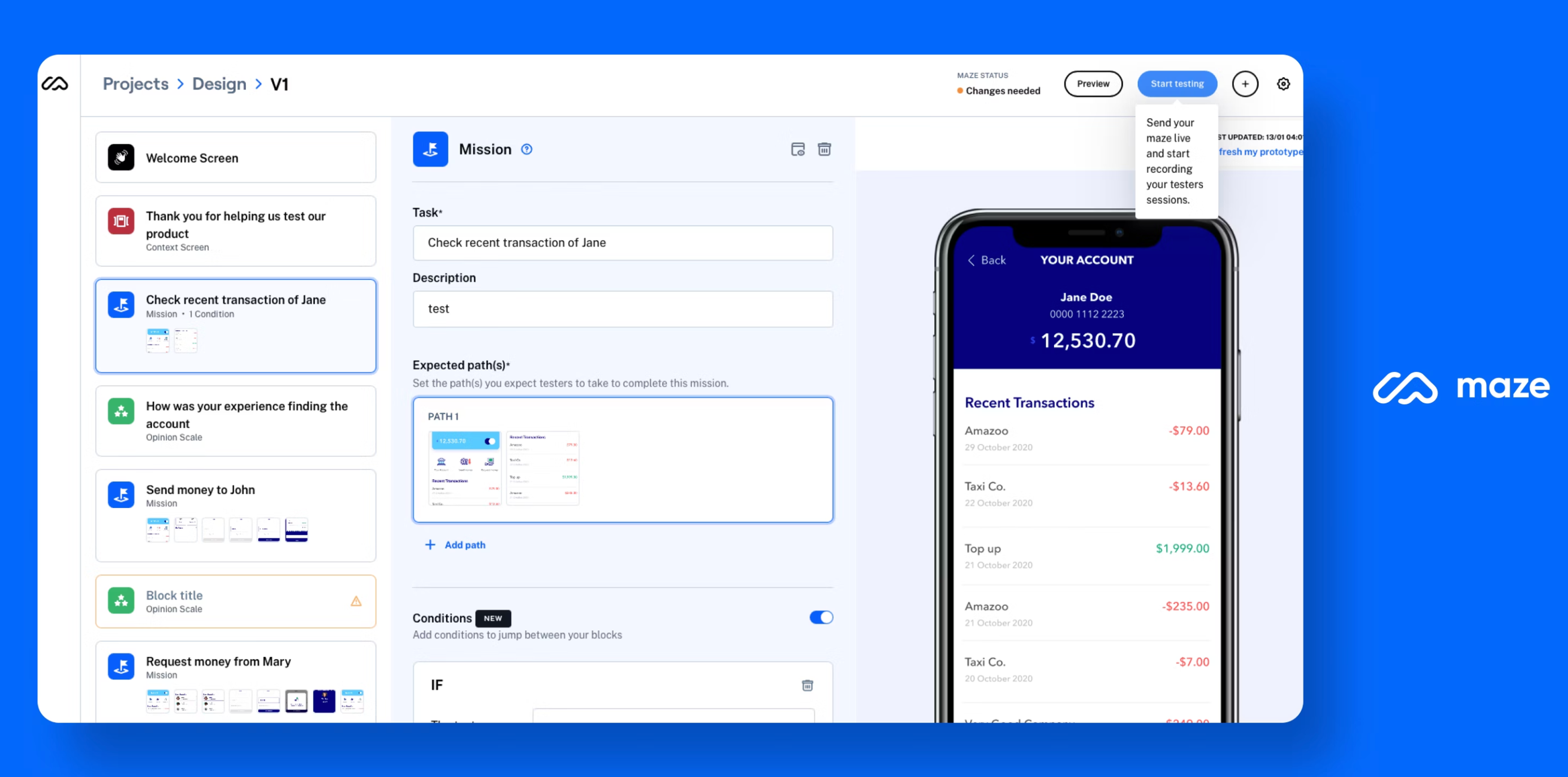
- Category: User Testing & Feedback
- Why it’s the best: Maze is great for quick user feedback and usability testing, making it a preferred tool for design validation without the need for code
- Price: Free, Starter $99/mo, Organization - custom pricing
- Available on: desktop
- Overall Rating: 4.2/5
Maze is a user testing and research platform that helps companies gather insights about their digital products. Founded in 2017, Maze offers a suite of tools designed to streamline the user testing process, making it faster and more accessible for teams of all sizes.
Prototyping tools play a crucial role in the design process and usability testing, transforming wireframes into interactive mockups that simulate user experience. Maze helps in testing and refining user interfaces, ensuring they are both visually appealing and functional.
Selecting the right combination of UX tools is crucial for enhancing the user experience throughout various stages of product development, from ideation to testing.
The platform allows designers, product managers, and researchers to create and run various types of tests, including usability tests, surveys, and card-sorting exercises. Maze’s key feature is its ability to automate many aspects of user testing, from participant recruitment to data analysis.
This automation enables teams to conduct tests rapidly and frequently, supporting an iterative design process. The platform integrates with popular design tools like Figma, Sketch, and Adobe XD, allowing teams to import prototypes directly and start testing quickly.
This user experience platform has gained popularity among both startups and enterprise companies for its user-friendly interface and its ability to provide quantitative data alongside qualitative insights.
By offering features like heatmaps, success rates, and time-on-task metrics, Maze helps teams make data-driven decisions about their product designs. The company’s mission is to democratize user testing, making it an integral part of the product development process rather than an occasional, resource-intensive activity.
- Pros: Quick setup, no code required, good for user testing
- Cons: Limited prototyping capabilities, expensive for small teams
UIzard 3.0
Source: uizard

- Category: AI-powered UI/UX design and prototyping tool
- Why it’s the best: Leverages AI-driven automation to transform sketches into interactive prototypes within seconds.
- Price: Free, Pro - $12 per mon, Business - $39 per month
- Available on: Web-based platform (Compatible with Windows, macOS, and major browsers)
- Overall Rating: 5/5
UIzard is an AI-powered UI/UX design and prototyping tool that transforms sketches into interactive designs in seconds. With smart automation, real-time collaboration, and no-code functionality, it streamlines the design process for teams and individuals. Perfect for designers, developers, and product managers, UIzard makes creating high-fidelity prototypes faster and more intuitive than ever.
- Prons: Instantly converts sketches into interactive prototypes, speeding up the design process
- Cons: AI-generated designs may not always align with specific creative visions
Adobe After Effects
Source: New York Film Academy
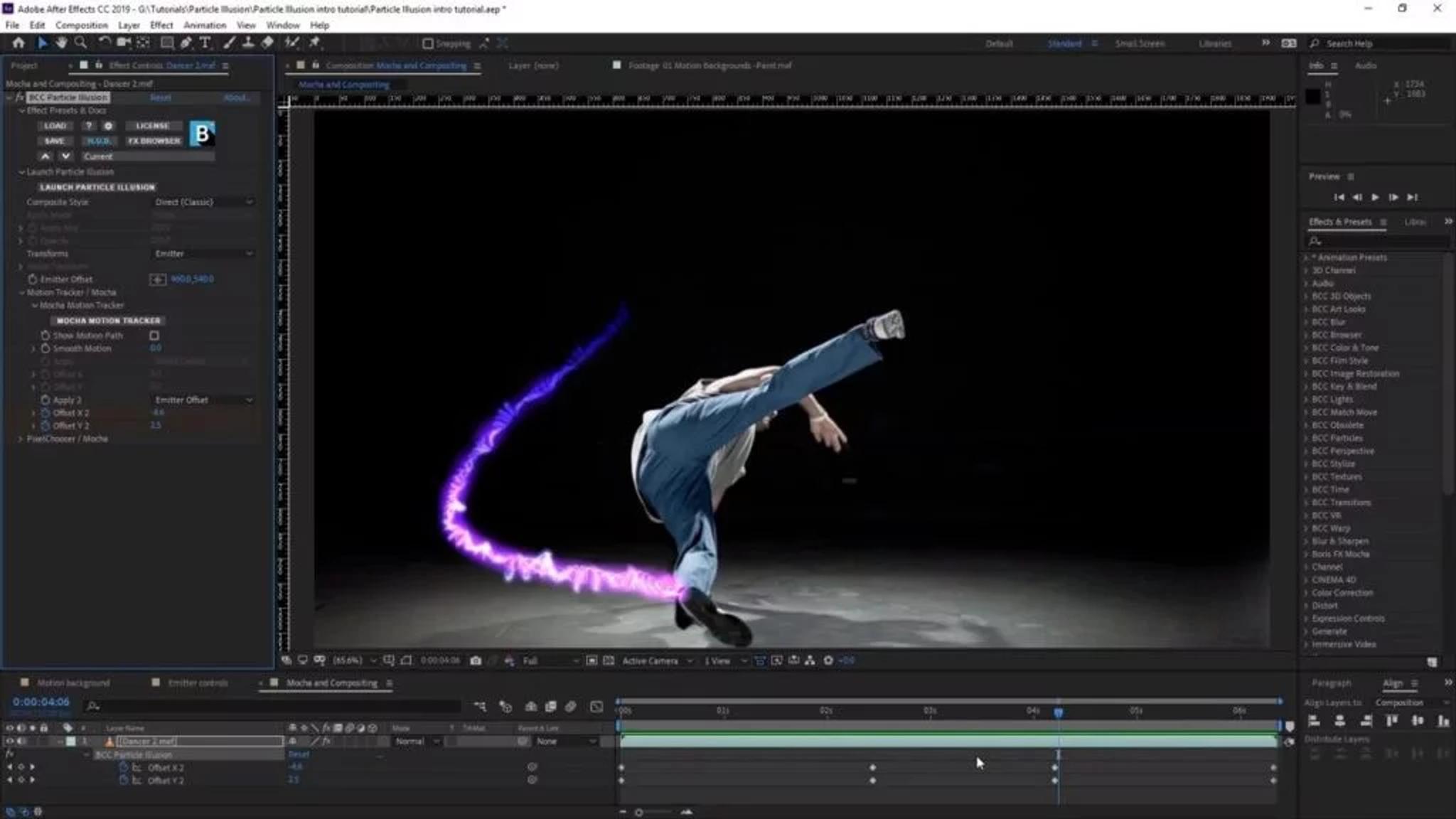
- Category: Animation & Motion Graphics
- Why it's the best: The industry standard for motion graphics and animation, Adobe After Effects is a powerhouse for anyone working with video content or interactive designs
- Price: After Effects $22.99/mo, Creative Cloud $59.99/mo
- Available on: desktop
- Overall Rating: 4.6/5
Adobe After Effects is a powerful digital visual effects, motion graphics, and compositing application developed by Adobe Inc. It is widely used in the post-production process of filmmaking, video production, and animation. After Effects allows artists and designers to create sophisticated motion graphics and visual effects for film, television, video, and web content.
The software provides a comprehensive set of tools for creating and manipulating 2D and 3D animations, applying various effects, and compositing multiple layers of video and images.
Its key features include keyframe animation, motion tracking, rotoscoping, and the ability to work with a wide range of file formats. After Effects also integrates well with other Adobe Creative Suite applications like Photoshop, Illustrator, and Premiere Pro, allowing for a seamless workflow in complex projects.
Since its introduction in 1993, After Effects has become an industry standard in visual effects and motion graphics. It is used by professionals in various fields, including film and television production, advertising, web design, and corporate video production.
The software's versatility and extensive plugin ecosystem have contributed to its popularity, enabling users to extend its capabilities and create increasingly complex and visually stunning effects.
- Pros: Powerful animation capabilities, deep integration with Adobe ecosystem
- Cons: Steep learning curve, expensive for individual users
Optimizely
Source: Optimizely

- Category: A/B Testing & Optimization
- Why it's the best: A leader in the A/B testing space, Optimizely is widely used for advanced experimentation and optimization of websites and apps
- Price: a minimum of $36,000 USD per year
- Available on: desktop/mobile
- Overall Rating: 4.1/5
Optimizely is a leading digital experience platform (DXP) that helps companies optimize their websites, mobile apps, and other digital touchpoints.
Founded in 2010 by Dan Siroker and Pete Koomen, the company initially focused on A/B testing and website optimization but has since expanded its offerings to cover a wider range of digital experience solutions.
At its core, Optimizely provides tools for experimentation, personalization, and content management. Its platform allows businesses to conduct A/B and multivariate tests, segment audiences, and deliver personalized experiences to users based on their behavior and preferences.
This data-driven approach enables companies to make informed decisions about their digital strategies, improving user engagement, conversion rates, and overall business performance.
Over the years, Optimizely has grown through both organic development and strategic acquisitions. In 2020, it merged with Episerver, another prominent player in the digital experience space, further expanding its capabilities and market presence.
Today, Optimizely serves a diverse range of clients, from small businesses to large enterprises, across various industries, helping them create more impactful and tailored digital experiences for their customers.
- Pros: Powerful experimentation features, easy to run A/B tests
- Cons: Expensive, advanced features require technical knowledge
Stark
Source: getstark.co

- Category: Accessibility & Inclusive Design Tool
- Why it’s the best: Stark is the leading accessibility tool for designers and developers who want to build more inclusive digital products. It integrates directly into popular design and development tools like Figma, Sketch, Adobe XD, and Chrome - making it seamless to check contrast, color blindness, typography, and other accessibility factors in real time.
- Price: Free; Launch: $2,500 per year; Grow: $6,000 per year; Scale: $15,000 per year
- Available on: Figma, Sketch, Adobe XD, Chrome, macOS, Windows
- Overall Rating: 4.8/5
Stark is a powerful accessibility tool that helps designers and developers create more inclusive digital experiences. It integrates directly with design platforms like Figma, Sketch, and Adobe XD, as well as web browsers like Chrome. With Stark, teams can check for contrast issues, simulate color blindness, inspect typography, and ensure their work aligns with accessibility guidelines like WCAG—all without leaving their workflow.
What makes Stark stand out is its focus on simplicity and real-time feedback. Instead of running separate audits or relying on third-party tools, users get instant accessibility checks while designing. This helps catch issues early in the process, saving time and effort while ensuring that products are usable by everyone, including people with disabilities.
Stark also offers educational content, accessibility checklists, and team collaboration features, making it great for organizations aiming to build accessibility into their design culture. Whether you're working solo or across large teams, Stark supports a shift toward more inclusive thinking and design habits without overwhelming you with technical jargon.
While Stark is incredibly helpful, it doesn’t replace full accessibility audits or testing with real users. It’s best used as a proactive design assistant rather than a comprehensive compliance solution. That said, it’s an essential tool for any team looking to take accessibility seriously from the start.
- Pros: Seamless integration with design and dev tools
- Cons: Not a full replacement for full accessibility audits
Honorable Mentions
UserZoom is a comprehensive enterprise-level UX research platform designed to help large organizations gather and analyze user feedback throughout the product development lifecycle. It offers various research methodologies, including usability testing, card sorting, tree testing, and surveys. Each UX design tool listed can enhance different aspects of the design process, from gathering user insights to improving collaboration and efficiency.
UserZoom’s robust features allow teams to recruit participants, conduct moderated and unmoderated studies, and generate detailed reports with actionable insights.
Its enterprise focus means it integrates well with existing workflows and provides advanced collaboration tools, making it suitable for companies with complex research needs and multiple stakeholders.
UsabilityHub is a user testing platform that provides quick feedback on specific design choices. It offers a suite of five-second tests, preference tests, click tests, and first-click tests, allowing designers and researchers to gather rapid insights on everything from first impressions to navigation patterns.
The platform’s strength lies in its simplicity and speed, making it ideal for teams that need to validate design decisions quickly and iteratively. UsabilityHub’s panel of testers and easy-to-use interface make it accessible for both small teams and larger organizations looking to supplement their UX research efforts with fast, targeted feedback.
Whimsical is a collaborative visual workspace tool that excels at creating wireframes, flowcharts, and mind maps for brainstorming and early-stage design work. Its intuitive interface and drag-and-drop functionality make it easy for both designers and non-designers to sketch out ideas and concepts quickly, visualizing the user interface effectively.
Whimsical’s real-time collaboration features enable team members to work together seamlessly, whether in the same room or distributed across different locations. The tool’s focus on speed and simplicity makes it particularly useful for rapid prototyping, visualizing user flows, and facilitating design thinking workshops.
Read More
Conclusion
In conclusion, the landscape of UI/UX design tools offers a diverse array of platforms tailored to various stages of the design and development process. Each tool serves a unique purpose, from early-stage wireframing and prototyping to detailed user testing and feedback collection.
Each UX tool, such as Sketch, Figma, and Adobe XD, plays a crucial role in enhancing the design process and user experience by addressing specific user needs and workflows.
Whether it’s UserTesting for gathering real-time insights or Protopie for building advanced interactive prototypes, these tools enable designers to create user-centered experiences efficiently.
Creating an engaging user interface is crucial for delivering intuitive and satisfying user experiences.
The best choice depends on a team’s specific needs, but by leveraging the right mix of these tools, designers can streamline their workflow, enhance collaboration, and deliver more intuitive and engaging user experiences.
As UI/UX design continues to evolve, staying equipped with the right tools is essential for driving innovation and improving user satisfaction.


About Clay
Clay is a UI/UX design & branding agency in San Francisco. We team up with startups and leading brands to create transformative digital experience. Clients: Facebook, Slack, Google, Amazon, Credit Karma, Zenefits, etc.
Learn more

About Clay
Clay is a UI/UX design & branding agency in San Francisco. We team up with startups and leading brands to create transformative digital experience. Clients: Facebook, Slack, Google, Amazon, Credit Karma, Zenefits, etc.
Learn more


